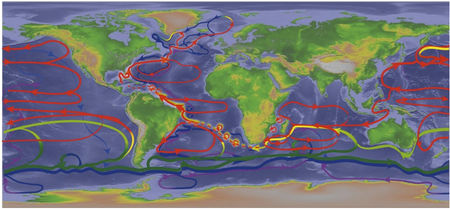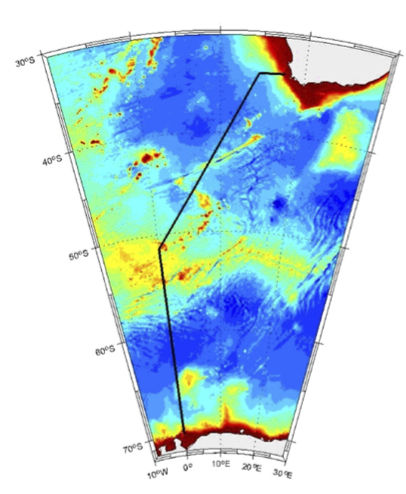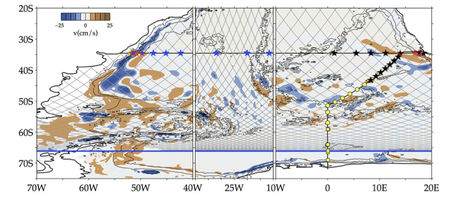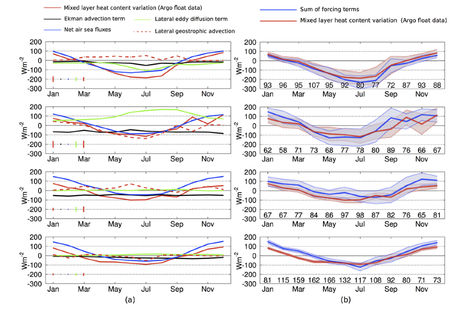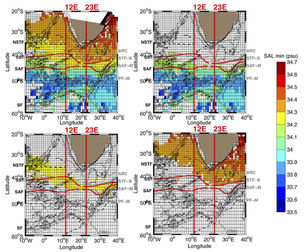The main objective of the South Atlantic Meridional Overturning Circulation (SAMOC) program is to study the variability of the Meridional Overturning Circulation in the South Atlantic. SAMOC keeps up the ongoing effort within a broader coordinated experimental context, focusing at the determination of an optimal observing network to monitor the global overturning circulation in the South Atlantic. It gathers 15 institutions and 8 countries (France, Brazil, South Africa, USA, Germany, Russia, Spain and Argentina). It has been endorsed by the Southern Ocean CLIVAR/CliC/SCAR and CLIVAR Panels.
Towards a South Atlantic observing network for the MOC
by S. Speich*, E.Rusciano, V. Faure, M.Ollitrault (a), S.Swart, I.Ansorge (b), S.Gladyshev(c), S. Garzoli, C.Meinen and G.Goni (d)
* Corresponding author : Sabrina SPEICH, speich@univ-brest.fr
(a) : Laboratoire de Physique des Océans, UMR 6523 CNRS-IFREMER-UBO, Brest FRANCE
(b) : CSIR - Southern Ocean Carbon & Climate Observatory, Rosebank SOUTH AFRICA
(c) : SIO RUSSIA
(d) : NOAA-AOML, USA
The Southern Ocean provides the principal connection between the Indian, Atlantic and Pacific ocean basins and between the upper and lower layers of the global ocean circulation. As a result, the overturning circulation within the Southern Ocean strongly influences climate patterns and the cycling of carbon and nutrients. It therefore stands to reason that any changes in the Southern Ocean will have global impacts. Limited observations suggest the Southern Ocean is indeed changing: the region is warming more rapidly than the global ocean average; salinity changes driven by shifts in precipitation and ice melt have been observed in both the upper and abyssal oceans; the uptake of carbon by the Southern Ocean has decreased, but has increased the acidity of the ocean. In response to these changes, Southern Ocean ecosystems are being forced to adapt or are diminishing in diversity and numbers. The lack of historical observations has slowed the progress of our understanding of the dynamics of the Southern Ocean and importantly its connections to the rest of the Earth's system.
Recent years have seen the advances in technology and knowledge needed to design and implement sustainable, multi-disciplinary, feasible and cost-effective observing systems for this remote environment. Since the 2000‘s and the beginning of the ARGO programme, a growing observing network has been setting up in the Southern Ocean.
In particular, since 2004, the international CLIVAR GoodHope programme allowed such an implementation in the Atlantic and Indian sectors of this ocean. This programme established a design of regular observations across the Southern Ocean between the African and Antarctic continents. By complementing the GoodHope programme observations with numerical modelling and sophisticated analyses it has been possible to improve our understanding of the Southern Ocean dynamics and to monitor the variability of the interoceanic connections. The partnership is gathering together means (in terms of human, observing platforms, ship time and general financial support) from 11 different institutions and six countries. The project aims at studying the full-depth oceanic exchanges between the Indian, Atlantic and Southern oceans, in a latitude band that encompasses the subtropical domain between South Africa and the Weddel Gyre.
The international collaboration built on GoodHope got reinforced and gathers now around a new international project, the South Atlantic Meridional Overturning (SAMOC : www.aoml.noaa.gov/phod/SAMOC and Speich et al. 2009). This project has different purposes within the international research devoted to climate variability and change. The main goal is to enhance the ongoing effort within a broader coordinated experimental context, focusing at the determination of an optimal observing network to monitor the global overturning circulation in the South Atlantic. It gathers 15 institutions and 8 countries (France, Brazil, South Africa, USA, Germany, Russia, Spain and Argentina). It has been endorsed by the Southern Ocean CLIVAR/CliC/SCAR and CLIVAR Panels.
In France, SAMOC is funded by the Agence National pour la Recherche (ANR), Ifremer (Ifremer), LEFE (LEFE), and GMMC (GMMC).
Scientific context
The Southern Ocean is not only a geographical link between the world ocean basins, but a very active climate sub-system in terms of air-sea exchanges, water mass formation and transformation and biogeochemical processes. Its role in climate is central and its sensitivity to climate change is shown to be extremely important. The Southern Ocean, and especially key regions like the South Atlantic, are crucial for interbasin exchanges altered by local air-sea interactions and diapycnal fluxes, particularly in regions of intense mesoscale activity.
The South Atlantic Ocean is unique in its role as a nexus and melting pot for water-masses formed elsewhere and transiting between the far regions of the World Ocean. Its mean meridional circulation involves a deep, southward, flow of cold and salty North Atlantic Deep Water and, a compensating northward flow that is a mixture of warm and salty surface waters and cooler and fresher Antarctic Intermediate Waters. At a much greater depth, the lowest limb of the MOC is driven by formation of very salty and cold Antarctic Bottom Water near the Antarctic coast, and this limb of the MOC stretches throughout the complete South Atlantic, interacting with the North Atlantic Deep Water flow along the way before returning south.
Figure 1 : Schematic of the MOC in the Atlantic Ocean with red indicating surface flows, yellow and green indicating intermediate flows, and blue and purple indicating deep flows. Figure adapted from Speich 2009, Lumpkin 2007
This complicated circulation pattern results in a significant equatorward oceanic heat flux, which is unlike any of the other ocean basins. Observations and models have shown that many of the components of the MOC in the South Atlantic are highly variable, with changes occurring on time scales ranging from a few days to many years. This variability is further complicated by the active transformation of these water masses as they pass through the South Atlantic. These changes occur across the entire basin, but are particularly intensified in regions of high mesoscale variability at the Brazil/Malvinas Confluence and at the Agulhas Retroflection. Observations show, for example, interannual variations in the sources that feed the Benguela Current, and hence in the upper ocean northward flow that eventually crosses the equator to reach the North Atlantic. It is this mounting evidence of the contribution of the South Atlantic to the global MOC system that has motivated broader study and international collaboration. The main objectives of the SAMOC initiative are to measure the strength and variability of the MOC as well as the meridional heat and fresh-water transport in the South Atlantic, all of which are crucial to improving our understanding of climate system variability.
Data and Methodology
Because of the lack of observations off Africa, the observational international GOODHOPE project was initiated in 2004 under the CLIVAR umbrella. The Goodhope field program aims to establish an intensive monitoring of the subtropical-subpolar region south of Africa. Since early 2004, 23 high-resolution XBT transects (two per year), six full-depth hydrological transects (five russian, one french-IPY Bonus Goodhope, two south-african in 2012) and two transects including CFCs and anthropogenic carbon estimates have been completed. More than 300 Argo profiling floats have been deployed, representing more than 30 000 vertical profiles in the Goodhope region (fig.2).
Figure 2 : Locations of the Goodhope CTD and XBT sections
To assess the role of the Southern Ocean in climate, physical measurements need to be fully integrated with biological and biogeochemical estimates, toward a complete understanding of the air-sea system. Conceived in this framework the enhanced multidisciplinary IPY cruise, BONUS-GoodHope, was realized in early 2008. A transect including full geochemistry, biogeochemistry and atmosphere observations, coupled with two long term bottom mooring (C-PIES). By coupling the ocean and atmosphere dynamics with biogeochemistry observations of the full water column, and studying the pathway of trace metals and isotopes from the atmosphere to the sediments, BONUS-GoodHope provides significant progress toward the synthetic understanding of physical, chemical and biological processes as well as air-sea and inter-ocean exchanges. More than 25 articles have been published and a special issue was published in Ocean Science and Biogeosciences.
Figure 3 : Schematic of the proposed trans-basin array along 34.5°S and the oblique Goodhope transect. Note the x-axis scale is stretched over western and eastern boundaries. Stars indicate the different components of the array that have been (or will be) submitted to respective funding agencies : eastern boundary PIES/CPIES by France-ANR (black stars), and western boundary bottom pressure gauges, CPIES and ADCP by Brazil/FAPESP/FACEPE (green stars) dynamic height moorings to USA/NSF (red stars), western boundary PIES/CPIES and interior PIES-DP to USA/NOAA (blue stars). Colour contours are of 27-year mean OGCM from the Earth-simulator (OFES) meridional velocity at 200m-depth. Jason ground-tracks are overlaid as light gray lines.
But the current range of observations being made south of Africa, and more generally in the South Atlantic Ocean, are not capable of monitoring the meridional overturning circulation, nor do they constitute a sustained observing system capable of monitoring large-scale interbasin fluxes of heat, freshwater, mass and other climate-relevant quantities. The SAMOC international programme aims at implementing an observational system together with modelling and theoretical studies to monitor the South Atlantic’s branch of the MOC. Figure 3 illustrates the ongoing/planned observations network to reach this objective.
Data from existing observational systems are also crucial for the SAMOC field program. These include ARGO float deployment and the high-density XBT transects along the 34.5°S (AX18), across Drake Passage (AX22) and south of South Africa (AX25). Others global observing systems, as the global drifter array, along with satellite observations of sea surface height, sea surface temperature and salinity and surface wind will provide a time-series of surface states.
Preliminary Results
With the relatively important number of GoodHope full-depth hydrographic cruises, high resolution XBT sampling, deployed profiling floats and satellite altimetry in complement with numerical simulation analyses we have been able to already improve quantitatively the knowledge on regional dynamics and water properties exchanged south of Africa. In particular the increased number of vertical profiles obtained by the repeat deployment of Argo floats along the GH line allowed us to make important progresses on the understanding and quantifying particular aspects of the regional dynamics. They include the estimate of the ACC variability for the upper 2500 m (Swart et al. 2010; Swart and Speich 2010; the regional mixing layer heat budget (Faure et al. 2010); aspects of the regional mesoscale dynamics (Gladyshev et al. 2008; Dencausse et al. 2011; Arhan et al. 2011); the Indo-Atlantic Antarctic Intermediate Water (AAIW) exchanges (Rusciano et al. 2012); global estimates of halothermosteric variability in connection with sea-level changes (von Schukman et al. 2012).
Hereafter we describe some of the results we obtained that are based, at least partially, on analyses of Argo data within the GoodHope project.
Mixing Layer Heat Budget (Faure et al., 2011)
While the oceanic region located south of South Africa has been studied extensively for its dynamical processes contributing to the transfer of Indian Ocean Central Water to the South Atlantic, other issues related to air-sea fluxes and water mass conversion, though also influencing the inter-oceanic exchanges, have been comparatively less examined in this area than at other longitudes of the Southern Ocean. A reason for this certainly resides in the fact that no Subantarctic Mode Water (SAMW) is formed in the SAZ south of Africa, unlike in the Indian Ocean and Pacific Ocean.
In this study we used ARGO hydrographic profiles, two hydrographic GH transects, and satellite measurements of air-sea exchange parameters to characterize the properties and seasonal heat budget variations of the Surface Mixed Layer (SML) south of Africa (Faure et al. 2011). Two recent studies using ARGO floats, though not focused on the region south of Africa, provide information on the SML heat balance in this sector of the Southern Ocean. Sallée et al. (2006), while studying the formation of SAMW in the southeastern Indian Ocean, found that upstream (west) of this formation area heating by eddy diffusion related to the nearby South Indian western boundary current system (the Agulhas Current and Agulhas Return Current) counterbalances the cooling due to air-sea fluxes and Ekman transport. Dong et al. (2007), in a circumpolar study of the Southern Ocean SML heat budget, underlined the role of air-sea fluxes at the seasonal time scale, and the relative weakness of the geostrophic advection term, in contrast with western boundary current regions.
The analysis distinguishes the Subtropical domain (STZ), and the SAZ, Polar Frontal Zone (PFZ) and Antarctic Zone (AZ) of the ACC. While no Subantarctic Mode Water forms in that region, occurrences of deep SML (up to ~450 m) are observed in the SAZ in anticyclones detached from the Agulhas Current retroflection or Agulhas Return Current. These are present latitudinally throughout the SAZ, but preferentially at longitudes 10°E-20°E where, according to Dencausse et al. 2011, the S-STF is interrupted. Likely owing to this exchange window and to transfers at the SAF also enhanced by the anticyclones, the SAZ shows a wide range of properties largely encroaching upon those of the neighbouring domains (Fig. 4).
Heat budget computations in each zone reveal significant meridional changes of regime. While air-sea heat fluxes dictate the heat budget seasonal variability everywhere, heat is mostly brought through lateral geostrophic advection by the Agulhas Current in the STZ, through lateral diffusion in the SAZ, and through air-sea fluxes in the PFZ and AZ. The cooling contributions are by Ekman advection everywhere, lateral diffusion in the STZ (also favoured by the ~10-degree breach in the Subtropical Front), and by geostrophic advection in the SAZ. The latter likely reflects eastward draining of water warmed through mixing of the subtropical eddies.
Figure 4 : Seasonal variations of the SML heat budget terms averaged over the period 2004-2008 (Faure et al., 2011)
Interocean exchanges of Antarctic Intermediate Water
Here again, a combination of Argo hydrographic profiles collected between 2004-2009 in the South Atlantic south of Africa and observations from the GoodHope hydrographic transect is achieved to describe the characteristic and the flow of Antarctic Intermediate Water (AAIW). The Argo raw data are reorganized in a 1°x1° grid in an area extending from 10°W to 40°E and from 20°S to 60°S. The AAIW characteristics are compared in nine different regions defined on the base of the regional Southern Ocean front that are relevant to the WWIW dynamics : the S-STF and the SAF. Following the method developed by Faure and al., 2011 for the determination of the fronts calculated from the Argo profiles, the different regional varieties of AAIW and their origins are determined : the A-AAIW (south-west Atlantic AAIW) with salinities lower than 34.2 ; I-AAIW (Indian AAIW) with salinities exceeding 34.3 ; and a new intermediate water - defined as IA-AAIW (Indo-Atlantic AAIW)- found north of the S-STF between 10°W and 12°E and south of the S-STF between 12°E and 40°E with salinities comprised between 34.2 and 34.3.
The collected Argo profiles show (fig.5) a quasi-zonal distribution of the salinity minimum values computed within AAIW on the isoneutral surfaces (37.3) on a grid 1°x1°. The zonal AAIW matches fairly well the SO fronts location. The Indian and Atlantic varieties of AAIW are separated by the S-STF in the western part of the domain ; the area of the north of the S-STF is largely dominated by I-AAIW with area-normalized volume values of about 5.4*102 m3/m2, west of 23°E. The A-AAIW volume, abundant between the S-STF and the SAF, decrease very importantly eastward of 12°E certainly due to the strong mixing between Indian and Atlantic varieties induced by the spawning of eddies in the Cape Basin.
Figure 5 : Salinity vertical minimum maps from Argo floats data. The subplots show Smin (top-left panel), S<=34.2 (top-right panel) ; 34.2<S<34.3 (bottom-left panel) and S>=34.3 (bottom-right panel) (source : Rusciano and al, 2012).
Making use of the recent developed ANDRO velocity dataset developed by Ollitrault and Rannou, 2011, the regional AAIW absolute geostrophic velocity and transport is estimated within the isoneutral layer. The AAIW has speed between 0.1-0.3 m/s in the Agulhas Current and 0.1-0.23 m/s in the Agulhas Return Current. AAIW flows in the subtropical region have a speed approximatively of 0.03 m/s. A net increase of the eastward transport is evident from 40°S to 60°S, in particular at the S-STF and PF locations. The transport accross the latitudinal lines shows an evident variability between 12°E-23)E, which represents the « frontal » window characterized by high mesoscale and submesoscale activity due to eddies and rings detected from in-situ observations and satellite altimetry.
Related links
SAMOC webpage : http://www.aoml.noaa.gov/phod/research/moc/samoc/
SAMOC workshops : http://www.aoml.noaa.gov/phod/SAMOC
CLIVAR/GOOHDOPE program : http://www.univ-brest.fr/lpo/goodhope/
BONUS-Goodhope : http://www.univ-brest.fr/IUEM/BONUS-GOODHOPE/
International Polar Year : http://www.ipy.org/
Partner Institutions
- Alfred Wegener Institute (Germany, Olaf Boebel)
- Department of Environmental Affairs (South Africa)
- IFM-GEOMAR, Leibniz-Institut fur Meereswissenschaften (Germany, Peter Brandt)
- Institut de Ciencies del Mar, CSIC (Spain, Jose Pelegri and Antonio Olivares)
- Laboratoire de Physique des Oceans (France, Sabrina Speich)
- Massachusetts Institute of Technology (USA, Sheekela Baker-Yeboah and Glenn Flierl)
- NOAA Atlantic Oceanographic and Meteorological Laboratory (USA, Silvia Garzoli, Gustavo Goni, Chris Meinen, and Molly Baringer)
- Servicio de Hidrografia Naval (Argentina, Ariel Triosi)
- Shirshov Institute of Oceanology (Russia, Sergey Gladysgev)
- Universidad de Buenos Aires (Argentina, Alberto Piola)
- Universidade de Sao Paulo (Brazil, Edmo Campos and Antonio Fetter)
- Universidade Federal do Rio Grande-FURG (Brazil, Mauricio Mata)
- University of California San Diego/Scripps Institute of Oceanography (USA, Janet Sprintall)
- University of Cape Town (South Africa, Isabelle Ansorge, Chris Reason, and Michael Roberts)
- University of Miami/RSMAS (USA, Shenfu Dong, Renellys Perez, and Rana Fine)
References
- Arhan, M., S. Speich, C. Messager, G. Dencausse, R. Fine, and M. Boye, 2011: Anticyclonic and cyclonic eddies of subtropical origin in the subantarctic zone south of Africa. J. Geophys. Res., 116, C11004, http://dx.doi.org/10.1029/2011JC007140
- Dencausse, G., M. Arhan, and S. Speich, 2010: Routes of Agulhas rings in the southeastern Cape Basin. Deep Sea Research Part I: Oceanographic Research Papers, 57, 1406-1421, http://www.sciencedirect.com/science/article/B6VGB- 50NYWSW-2/2/5b6d97b9ef78d312057448a946d58df6
- Dong, S., S. T. Gille, and J. Sprintall, 2007: An assessment of the Southern Ocean mixed layer heat budget. Journal of Climate, 4425-42.
- Dong, S., S. L. Garzoli, and M. Baringer, 2009: An assessment of the seasonal mixed layer salinity budget in the Southern Ocean. J. Geophys. Res., 114, C12001.
- Dong, S., M. Baringer, G. Goni, and S. Garzoli, 2011: Importance of the assimilation of Argo float measurements on the Meridional Overturning Circulation in the South Atlantic. Geophysical Research Letters, 38, L18603, http://dx.doi.org/10.1029/2011GL048982
- Faure, V., M. Arhan, S. Speich, and S. Gladyshev, 2011: Heat budget of the surface mixed layer south of Africa. Ocean Dynamics, 1-18, http://dx.doi.org/10.1007/s10236-011-0444-1
- Gladyshev, S., M.Arhan, A.Sokov, S.Speich, 2008 : A hydrographic section form Aouth Africa to the southern limit of the Antarctic Cicumpola Current at the Greenwich meridian. Deep Sea Research, 55, 1284-1303
- Legeais, J.-F., S. Speich, M.Arhan, I.Ansorge, E.Fahrbach, S.Garzoli and A.Klepikov, 2005 : The baroclinic transport of the Antarctic Circumpola Current south of Africa, GRL doi:10.1029/2005GL023271
- Lumpkin, Rick, Kevin Speer, 2007: Global Ocean Meridional Overturning. J. Phys. Oceanogr., 37, 2550–2562. doi: http://dx.doi.org/10.1175/JPO3130.1
- Rimaud, J., S. Speich, B. Blanke, and N. Grima, 2012: The exchange of Intermediate Water in the southeast Atlantic: Water mass transformations diagnosed from the Lagrangian analysis of a regional ocean model. Journal of Geophysical Research-Oceans, 117, n/a- n/a, http://dx.doi.org/10.1029/2012JC008059
- Rusciano, E., S. Speich, and M. Ollitrault, 2012: Interocean exchanges and the spreading of Antarctic Intermediate Water south of Africa. Journal of Geophysical Research-Oceans, 117, http://dx.doi.org/10.1029/2012JC008266
- Sallée, J.B.; Speer, K.; Morrow, R. and Lumpkin, R. An estimate of Lagragian eddy statistics and diffusion in the mixed layer of the Southern Ocean, Journ. of Marine Res., 2008, 66(4), 441-46
- Sallée, J.B. Les eaux modales de l'Océan Austral (Southern Ocean Mode Waters), Ph.d Thesis, Toulouse III University, 2007
- Sallée, J.B. ; Wienders, N. ; Morrow, R. and Speer, K. Formation of Subantarctic mode water in the Southeastern Indian Ocean, Ocean Dynamics, 2006 , 56 , 525-542
- Speich, S., J. Lutjeharms, P. Penven, B.Blanke, 2006 : The Indo-Atlantic exchange : dynamics of a regime transition from a western boundary current to an eastern boundary system. GRL, 33, L23611, doi:10.1029/2006GL027157
- Speich S., B. Blanke and W. Cai, 2007 : Atlantic Meridional Overurturning and the Southern Hemisphere Supergyre. GRL, 34, L23614,doi:10.1029/2007GL031583
- Swart, S., Speich, S., Ansorge, I.J., Goni, G.J., Gladyshev, S. and Lutjeharms, J.R.E. 2008. Transport and variability of the Antarctic Circumpolar Current south of Africa. Journal of Geophysical Research, 113, C09014, doi:10.1029/2007JC004223.
- Swart, S., S. Speich, I. J. Ansorge, and J. R. E. Lutjeharms, 2010: An altimetry-based gravest empirical mode south of Africa: 1. Development and validation. J. Geophys. Res., 115, C030

